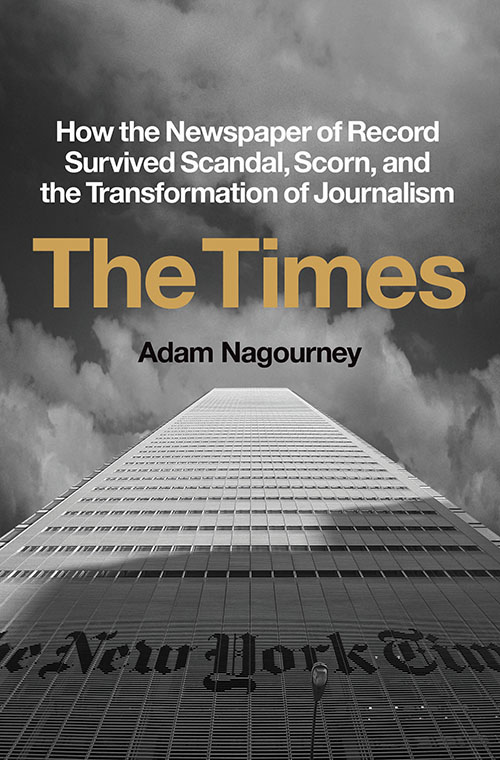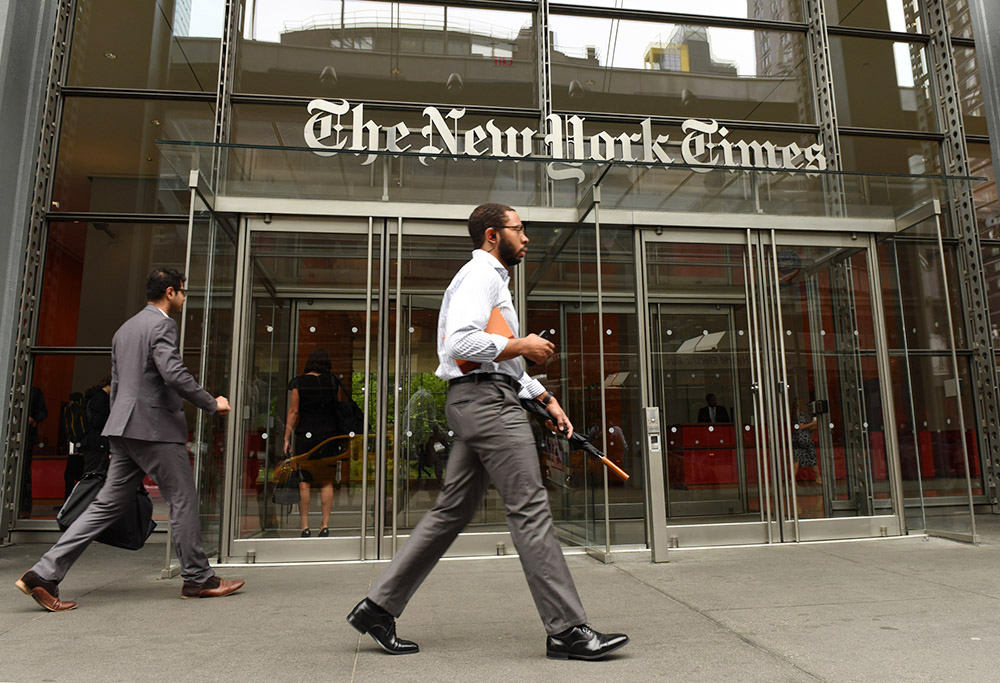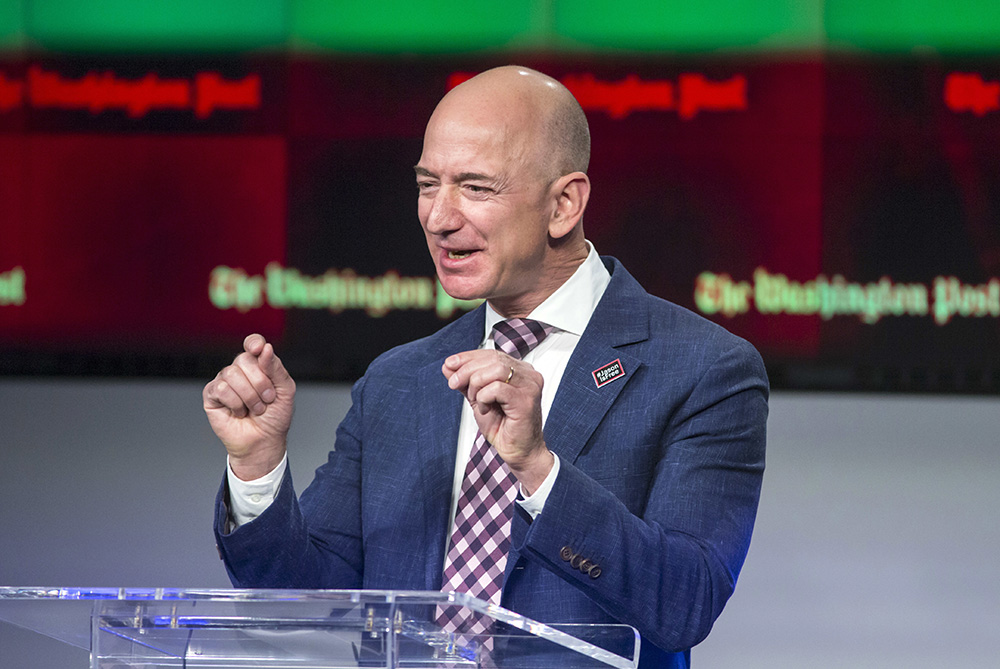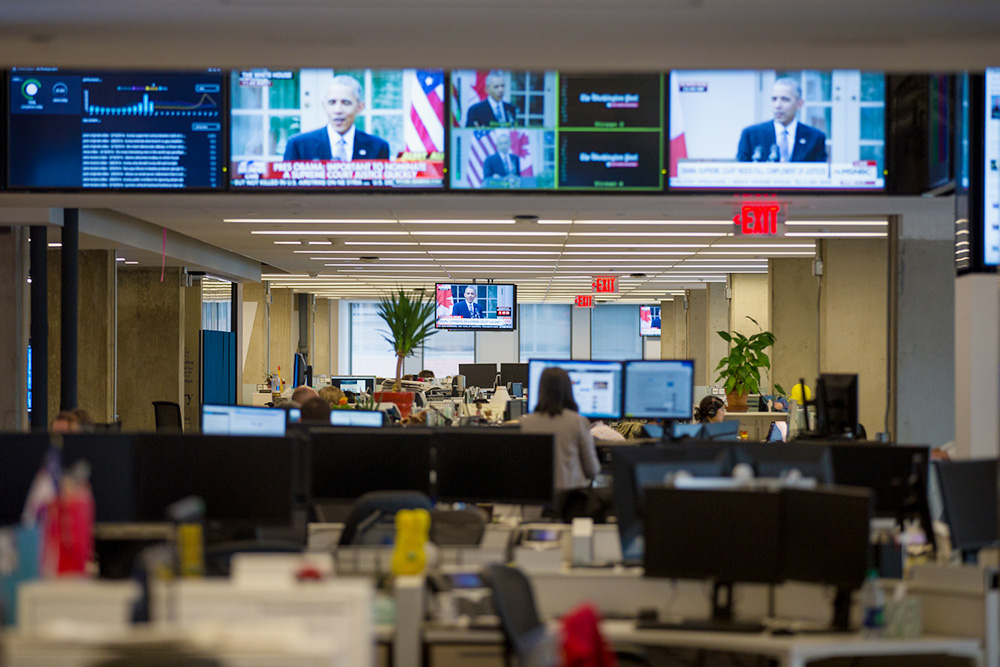
(Dreamstime/Deanpictures)

Collision of Power is an apt title for the new memoir by journalist Martin Baron, and not just the collision of "Trump, Bezos, and The Washington Post" highlighted in the subtitle.
Baron, who retired as executive editor of the Post in February 2021, provides a participant's account of the forces buffeting news organizations everywhere. He puts a face — often his own — on the clash of print and digital platforms; the tensions between social and traditional media; the efforts of a free press to publish information sealed off by secretive government agencies.
So, too, does The Times by Adam Nagourney deliver more than what's promised in its subtitle: "How the Newspaper of Record Survived Scandal, Scorn, and the Transformation of Journalism."
Nagourney, who joined The New York Times as a reporter in 1996, gained extraordinary access to the correspondence and other records of the organization's key leaders from 1977 to 2016. Supplemented by 300 interviews over the course of more than five years, those documents provided Nagourney with rich material for a colorful portrait of the Old Gray Lady.
These are big books, beginning with their page counts.

Too much for general readers? Perhaps, but my hunch is that serious consumers of national and international news — a market niche well-represented among NCR members and subscribers — will appreciate the context these books provide for the journalism both newsrooms produce.
If you'd like to get a sense of the books before diving in, you can view this friendly conversation about Baron's book between Baron and retired New York Times editor Dean Baquet, as well as this discussion of Nagourney's book between Nagourney and one of his colleagues, Times reporter Maggie Haberman.
Both books examine how the people in charge of their respective newsrooms deal with the power handed to them along with their titles — and how that power is shifting in the digital age.
Nagourney chronicles the personalities and struggles of a half-dozen Times executive editors, two of whom were fired, and three publishers named Sulzberger: the current one, known as A.G.; his father (Arthur); and his grandfather (Punch).
Baron, who applies a tighter focus and time frame (his own 2013-21 term as executive editor), documents his share of internecine battles. But he is more concerned with threats to the paper, if we can still call it that, beyond its walls.
Chief among them: Even 30 years after news organizations published their first digital editions, the impact of the internet on print journalism has still not sorted itself out. The impact of the internet disruption has been far more devastating for smaller, metropolitan newspapers unable to attract the kind of national and international digital readers and advertisers that help support the Times and the Post.

People are seen near the entrance of the New York Times building in New York City May 31, 2018. (Dreamstime/Bumbleedee)
At papers big and small, though, print circulation has fallen dramatically. Average daily circulation of the Times plummeted from 1,230,461 in 1993 to 296,329 this year, a 76% decline. The Post lost 83%, dropping from 833,332 to 139,230.
Another telling indicator: The Times spent about $1.4 billion to buy The Boston Globe and the Worcester Telegram & Gazette in 1993, selling them 20 years later for about $70 million.
"It was a huge miscalculation," Nagourney says of the ill-fated investment, arguing that it "underlined how much Punch Sulzberger and others in his generation did not see what was becoming so visible to their younger associates: that the internet would transform the newspaper business."
Since then, the Times and the Post have generated substantial new cash via their paywalls but one much more than the other — the Times with 9.4 million digital subscribers, more than triple the Post's 2.5 million.
Why such a gap? "Importantly," Baron says of the Post, "unlike The Times, we had not insinuated ourselves into people's daily, non-news routines." If you pay to play the Times' Wordle or Spelling Bee games — or perhaps access recipes at cooking.nytimes.com — you know what he's talking about.

Martin Baron, then executive editor of The Washington Post, smiles during a newsroom celebration April 16, 2018, after the newspaper won two Pulitzer Prizes. (AP/Andrew Harnik, File)
In terms of personal mistakes, Baron describes his failure to seek a top-level editor to address diversity issues in the Post's coverage and staffing as "regrettably the most serious error of my tenure at The Post."
(Both Baron and Baquet, the retired Times editor, acknowledge that the surprise election of Donald Trump in 2016 exposed the failure of both newsrooms to listen carefully enough to what people were thinking and saying around the country.)
Presidential elbow pokes at a secret White House dinner
Baron opens his book with previously undisclosed details of a small, secret dinner at the White House in June 2017. Seated to the left of Trump, Baron recalls the president repeatedly jabbing him with his elbow as he denounced the Post's coverage as "awful."
Also at that dinner was the third richest man in the world, Amazon founder Jeff Bezos, who had purchased the Post for $250 million in October 2013, less than a year after Baron joined the paper.
Trump followed up at 8 a.m. the next day with a call to Bezos' mobile phone, pushing Bezos to get the Post to be "more fair to me."
Baron reports that Bezos demurred, telling Trump, "I'd feel really bad about it my whole life" if he interfered with news coverage.

Billionaire Amazon founder and Washington Post owner Jeff Bezos talks about the history and character of the Post during a dedication ceremony for its new headquarters in Washington, D.C., Jan. 28, 2016. (AP/J. Scott Applewhite, File)
Baron says Bezos stuck to his hands-off stance on coverage throughout Baron's time as editor.
He also says he grew to like and respect Bezos, and managed to avoid or make acceptable most of the new owner's suggestions for organizational innovations. (Among the Bezos ideas that survived was one championed by his former wife, MacKenzie: the "Democracy Dies in Darkness" slogan that appears beneath the paper's name in print and online.)
Baron says Bezos never interfered with the Post's coverage of Amazon, other companies he owns or his personal life.
Baron adds: "If there was bias in our coverage of Amazon, it was toward subjecting the company to extra scrutiny," a claim he buttresses with a quote from media critic Jack Shafer of Politico: "If anything, the paper has been more aggressive on Amazon stories, often beating competitors to the punch."
The Columbia Journalism Review disagrees, arguing in a piece headlined "The Washington Post has a Bezos problem" that media ownership by an economic force like Bezos represents an inherent conflict of interest that The Post still needs to address.
Advertisement
Power shift to big tech firms
Baron points readers to a congressional investigation of digital competition that addresses abuse of power by big tech companies.
"These [big tech] firms typically run the marketplace while also competing in it," the report concludes, "a position that enables them to write one set of rules for others, while they play by another."
Interestingly, just as smaller retailers find themselves at the mercy of Amazon's control of the marketplace, so, too, does the Post suffer the consequences of an advertising market now controlled by the likes of Facebook and Google.
Millions of retailers, their foot traffic dramatically diminished by online sales, now must follow Amazon's rules in order to sell their goods and services on the Amazon platform.
And with sites like Google and Facebook generating the vast majority of advertising revenue, print newspapers' share of that revenue fell from 53% in 2000 to 5% in 2020.
Framing the journalistic role as one not opposing Trump but instead covering him aggressively, Baron made an observation that became a trademark of his approach: 'We're not at war. We're at work.'
Baron, who served as The Boston Globe's top editor from 2001 to 2013, notes that he was portrayed as "humorless, laconic, and yet resolute" in the "Spotlight" movie chronicling the Globe's investigation of clergy sexual abuse.
In his book, Baron recounts the ways he remained resolute on issues that proved divisive with much of his staff and with some media leaders and thinkers.
The main points of conflict: the extent to which journalists should be free to express their personal and political views on social media (not very, Baron argues) and the stance journalists should take in coverage of disingenuous politicians like Trump.
Framing the journalistic role as one not opposing Trump but instead covering him aggressively, Baron made an observation that became a trademark of his approach: "We're not at war. We're at work."

A view of the Washington Post newsroom in Washington, D.C., in spring 2016 (Dreamstime/Alexander Khitrov)
Baron says issues involving diversity and social media caused growing fissures between him and his staff. As much as he'd hardened himself to attacks by Trump and others complaining about coverage, he says, "the invective leveled against me by colleagues — whose skill and bravery I admired and whose news organization I had busted my butt for eight years to turn around — was tougher to take. Nothing was more hurtful."
By mid 2020, Baron says he was "feeling physically vulnerable and drained," citing a steadily worsening genetic bleeding disorder that was causing "sudden, severe and seemingly unstoppable nosebleeds."
Although publisher Fred Ryan persuaded him to stick it out until February 2021, Baron reports that, many months earlier, his "desire to continue working at The Post was disintegrating."
Anybody who's anybody reads the Times
Nagourney opens his book with a profile of Abe Rosenthal, the legendary New York Times editor who ran the place from 1969 to 1986 and is described by the author as "a package of brilliance and insecurities."
In a single paragraph, Nagourney sums up what may be the Times' greatest strength and limitation:
You have to understand this, Rosenthal once said to a young reporter in his office ... When an educated, important person anywhere in America runs into another educated, important person anywhere in America, each will have assumed of the other that they have read The New York Times.
Rosenthal's world of "educated, important" people for the most part consisted of white, male and straight people, and Nagourney documents what it took over the years to widen that view of Times staffers as well as readers.
With some notable exceptions, Nagourney is probably right when he asserts, "Newsrooms as a rule are unhappy places: roiled by self-doubt, anger, competitiveness, resentments, and vindictiveness. There may well have been no newsroom in the country as unhappy as the one Abe Rosenthal ran for those seventeen years. But few were as good."
Indeed, both Nagourney and Baron recount extraordinary journalistic achievements by the staffs of both papers. But as journalists do, they devote more attention to digging into what didn't turn out so well.
For Nagourney, that means explaining how the Times became a cheerleader for the March 2003 invasion of Iraq by falling for the government's lies and deceptions regarding weapons of mass destruction. And it means probing how and why Jayson Blair was able to inflict his plagiarism and fabrications on Times readers before his editors finally caught up with him in May 2003.
The executive editor in charge at the time of both fiascos, Howell Raines, was fired less than a month after the Times ran a 7,239-word investigation of Blair's deceptions.
But it was also Raines who, less than two years earlier, had led the Times' coverage of the 9/11 terrorism attacks and their aftermath, work that would earn the paper seven Pulitzer Prizes.

People line up to buy newspapers on Sept. 12, 2001, after the Sept. 11 terrorist attacks on the World Trade Center in New York City. (AP/Chad Rachman)
Nagourney reports that, in the midst of overseeing 66 stories about the attacks for the Sept. 12, 2002, paper, Raines paid scant attention to how the Times was covering the story online.
"But if the attacks proved to be a defining moment for the new executive editor," he writes, "they would turn out to be even more transformative for the website — a demonstration of the potential of the internet to do what the print newspaper could not: provide information to a huge readership that was hungry for minute-to-minute coverage."
Innovation and enterprise from below
The idea for the most striking feature of the Times' 9/11 coverage came from two staff members whose names appeared nowhere on the masthead.
Faced with overwhelming reports of people unaccounted for after the attacks, reporter Janny Scott and Christine Kay, a metro desk editor, proposed writing brief essays about individual victims. The work distinguished the Times' coverage in ways that helped earn it the biggest of Pulitzer honors: the Gold Medal for Public Service.
Initially headlined "Among the Missing," the collection of 2,310 essays was eventually called "Portraits of Grief" and became a model of journalistic innovation and enterprise.
Nagourney's detailed reconstruction of the 9/11 coverage and other key moments over four decades reflects his deep familiarity with the institution and its people, a journalist able to secure a level of access afforded a trusted colleague.
As insiders, though insiders of a different sort, Nagourney and Baron both got their hands on information not likely getable by less connected chroniclers.
By the same token, it's worth wondering if more independent investigators might have probed more deeply the consequences of these media powerhouses becoming part of the power establishment they're charged with holding to account.
For now, that task rests with us, the readers.








